
Who Were
The Cambs
The Cambs
at War
1/1st Btn 1914-1919
1914 - 1/1st Overview
1915 - 1/1st Overview
1915 - St Eloi
1915 - Fosse Wood
1916 - 1/1st Overview
1916 - The Schwaben
1916 - St Pierre Divion
1917 - 1/1st Overview
1917 - St Julien
Insignia, Medals & Books
Remembering The Cambs
Biographies
About Us &
This Site
1918
January
On New Years day the men of the Cambs were back in the Ypres Salient and the Canal Bank area they had come to know so well. Finally having been in the Salient nearly constantly since late 1916 the Battalion was told they were moving and marched to Houtkerque on the 21st. After a stay of several days they moved by train to Chipilly and were informed they would be taking up positions in the line around Gouzeaucourt, south of Cambrai. The Cambs relieved a South African unit and moved into the trenches on the 31st January.
February
Much of the month of February was spent in the front line around Gouzeaucourt, when not in the line the Battalion was pulled back to a camp near Dessart Wood. Conditions in the line at Gouzeaucourt were an improvement on life in the Ypres Salient however the cold, shelling and raiding activity caused casualties most days when the Cambs were in the line.
March
The Battalions stay in the line around Gouzeaucourt continued until the 12th March when they were relieved and moved back to billets around Moislains. They were still at Moislains when the massive German Spring Offensive fell on the front lines. The first the Cambs knew of the situation was when they put on alert to move at 5.45am on the 21st March. The Cambs were ordered to move to Longavesnes and prepare an emergency defence line.
As the lines in front of the Battalion collapsed or fell back the extent of the breakthrough began to become apparent. Fighting along the hastily prepared defence line increased and casualties started to mount rapidly. By the 23rd the Division was ordered to withdraw to another defence line. The Cambs and Sherwood Foresters were ordered to fight a rear guard action in order to hold up the enemy. This rear guard action involved the Coys leap frogging back over each other fighting all the way.
The next week was spent in constant action, new lines were formed only to be pushed back and the process of delaying the enemy advance would start over again. All across the front the chaos, confusion and casualties led to the disintegration of traditional formations. The structure of battalions, companies, and platoons ceased to exist and composite units were quickly formed of men and stragglers from any available unit. Cooks, clerks and anybody else who could carry a rifle was pulled into the line.
Slowly the German advance was stalled and fresh divisions took over the front. The Cambs were pulled out of the line on the 30th March and moved to Longveuv. Losses had been heavy and since the start the 21st the Cambs had over 380 men killed, wounded or taken prisoner. A full account of the Cambs during this time can be found by clicking here.
April
The shattered remains of the Cambs, like most of the units from the Division, were formed into a Composite Battalion until they could be rebuilt and the scattered men found. Although kept on heightened readiness in case the front collapse again the men were slowly moved across to Voormezeele south of Ypres. They entered the front line there on the 15th April and remained in the area until relieved on the 29th. During this time the thinly held line was subject to fierce artillery and gas attack and casualties amongst the composite units were heavy. A more detailed account of the Battalion in April 1918 can be found here.
By the end of April losses over the last six weeks had been so heavy that the whole of the 39th Division's infantry including the Cambs were merged into just two composite battalions. They took their place in the trenches near Hallebast, luckily a quieter sector of the line.
May
On the 3rd May the battered remnants of the 39th Division were pulled out and moved to Ruminghem. Here the men were told that the Division would not be rebuilt and the Brigades were being split up. After the losses during the German Spring Offensive and the previous years of fighting many of the battalions were simply struggling to keep up with replacements. Due to this many were being merged together. The Cambs were told they were being moved to the 35th Brigade, 12th Division and were going to take on around 400 men from the 7th Suffolks who were being reduced to a Training Cadre.
The Cambs moved by train to Lealvillers and then onto Acheux arriving there on the 19th May. Here the 11 officers and 408 other ranks from the 7th Suffolks joined the Cambs and on the 20th the new Battalion was in the line near Mailly-Maillet. They left the line on the 27th and moved to billets around Raincheval. A more detailed look at this merger and the changing composition of the Cambridgeshires can be found here.
June
The Cambs stay at the Rainhceval billets was spent training and forming the new Battalion into an effective fighting unit. Emphasis was put on "open fighting" in order to ready the men for the intended break through of the enemy lines. The Battalion moved back into the front line on the 22nd June. On the night of the 30th they carried out a small raid on a German position to their front. Further details about the Battalion during June and July 1918 can be found by clicking here.
July
The Cambs left the front on the 9th July and moved back to Herissart, Rumigny and then Canaples. During their stay at the various camps and billets the intense training and preparations continued.
August
The much awaited Allied offensive that came to be known as the Hundred Days Offensive was launched on the 8th August. In the sector that the Cambs were to attack the Germans had launched a surprise attack on the 6th August and captured an area of the British line near the village of Morlancourt. The Cambs role in the opening day of the Allied offensive was as part of the assault on these lost positions and the village of Morlancourt. The Cambs attack initially stalled due to stiff defence, the fighting was bitter and brutal but slowly the enemy positions were captured. By late afternoon the rest of the objectives were taken. A more detailed account of the fighting at Morlancourt can be found by clicking here.
The Cambs remained in the line until the 19th when they were moved into reserve. After several days resting and re-equipping they moved into position for the next attack. On the 22nd August the Cambs were ordered to attack the area east of Morlancourt, towards the Meaulte Road. The attack started badly owing to the promised tank support not being effective. The enemy MG positions caused many casualties on the assault Coys and the accurate enemy artillery fire added to the chaos. Slowly objectives in some places were taken but the heavy fighting continued. Losses for the 22nd August were 37 men killed and around 100 wounded. For a more detailed account of this attack and the events of late August please click here.
The fighting towards Bapaume continued and the Cambs returned to the line after a day to recover. Slowly the offensive ground down the enemy positions and it was looking like there would be a breakthrough. In torrential rain the assaulting battalions continued to hammer at the German lines and the Cambs held their positions from counter-attacks. After nearly a week of fighting and advances the Cambs were ordered to attack once again, this time at Maltz Horn Ridge.
The assault went in and many enemy prisoners were taken as the Cambs cleared the positions. Around 9pm the Cambs suffered a terrible blow when a German artillery shell scored a direct hit on the Battalion HQ. It crashed through the roof killing or wounding nearly all those present. Lt Col Saint was mortally wounded and died some hours later. Maj Clayton, the Second in Command and another pre-war officer who had been serving with the Battalion overseas for a long time, took command. The Battalion was relieved later that night.
Over the following days the front line kept advancing and the Cambs remained around Maltz Horn Ridge, now well behind the British line. The time was spent reorganising and rebuilding the exhausted and depleted Coys.
September
After a brief time to rest the Cambs went back into the line and offensive. Their next attack was on the 5th September around the village of Nurlu. Under thick fog and a heavy German gas bombardment then men made their way to the starting positions. The artillery bombardment that was meant to proceed their assault was minimal and ineffective. As the fog lifted the Cambs attacked. Thick wire and heavy MG fire led to heavy losses especially amongst B Coy who became pinned down. The attack stalled against the well defended positions and using the cover of darkness the Coys regrouped and were repositioned.
The following morning the Coys attacked again and quickly gained the upper hand. The enemy positions were cleared and the German pulled back to their next line of defence. The next assaulting battalions came up and the Cambs pulled back for a rest around Riverside Wood. Losses for the 5th and 6th were 29 killed and around 70 wounded. A more detailed account of the attack on Nurlu and early September can be found by clicking here.
The Cambs rest lasted until the 17th September when once again they were readied for the next assault. The advance had continued and the German line now ran through the village of Epehy, the Cambs were given the task of assaulting the village itself. The attack went in on the 18th, once again the weather was terrible and heavy rain made the going tough. For a more detailed account of the capture of Epehy and the fighting east of the village, please click here.
Brutal close quarter fighting to clear the village continued throughout the day. The arrival of reinforcements in the form of men from the Berkshires tipped the balance and slowly the strong points fell. After a complicated manoeuvre the Coys were repositioned and a further assault was launched the following day. This assault was tasked with clearing the German trenches still holding out to the east of the village. After a vicious close quarter battle a section of the enemy trench was captured and the Cambs continued pushing over the next few days. They were finally relieved and moved back from Epehy late on the 23rd.
October
The Cambs had several days rest and time to reorganise themselves after the fighting at Epehy. They were then moved to the Vimy Ridge area and on the 6th October they were back in the line this time near Oppy. On the 9th the enemy was found to have withdrawn from a section of the line and it was quickly occupied. More details about this time can be found here. This was the start of a series of retreats that led to a lot of ground being taken over the next few days. By the 14th the enemy line solidified around the village of Auby. The Cambs were tasked with breaking and clearing the village.
Despite the supporting Battalion on the Cambs right flank being delayed and casualties from friendly artillery fire, the men succeeded in taking most of the village. They were relieved late on the following day and moved to billets in Henin-Lietard. A full account of the fighting at Auby can be found by clicking here. Their stay there was cut short when word came through the enemy had fallen back and the advance was on once again. The Cambs continued with the advance until they were withdrawn from the line on the 26th and moved to billets at Raches.
November
On the 5th November the Cambs left Raches and moved to Le Hennoy. After a short stay they moved to Odomez carrying out various road repairs on the way before arriving at Hergnies late on the 10th. It was at Hergnies early on the 11th November that the Battalion received the news of the Armistice. Further details about the weeks leading up to the Armistice can be found by clicking here.
The road repairing continued and the Cambs moved on to Bonsecours. A Thanksgiving service was held on the 17th and a Battalion inspection on the 21st. The Cambs moved once again and reached Somain on the 26th where they were billeted.
December
A few men had already started being sent home but those still in France were kept busy training, carrying out salvage work or other similar duties. The Cambs remained billeted at Somain for all of December.
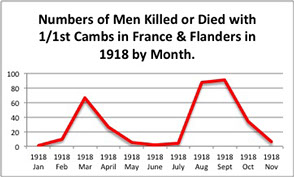
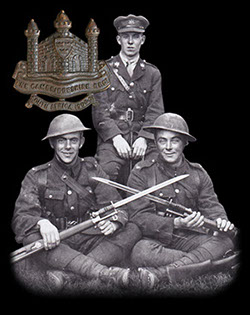
A Cambs officer and American soldiers.
Menu of 1918 Related Pages
October 1917 - January 1918
February - March
German Spring Offensive - Part 1
German Spring Offensive - Part 2
April - The Defence of Voormezeele
Changing of the Guard
Preparing for Victory, June - July 1918
Morlancourt, 8th to 9th August
Morlancourt - A Tank Called Ju-Ju
Meaulte Road and Late August
Nurlu - 5th to 6th September
Epehy - 18th to 30th September
Early October
Auby - 14th October
Armistice - 15th Oct to 11th Nov

A Cambs Cpl & 12th Division souvenir card.
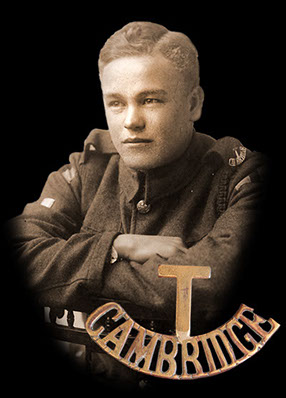
A young Cambs soldier killed in July 1918.
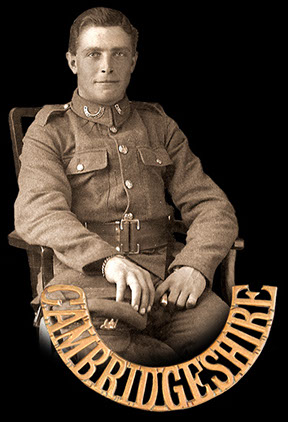
CSM Betts MC DCM & Bar killed 22-8-18.
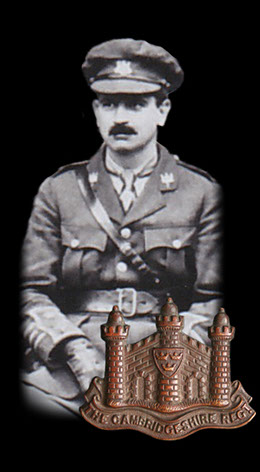
Lt Col Saint who died of wounds 29-8-18.
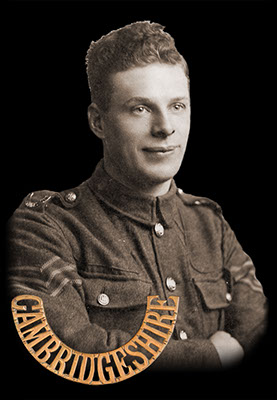
Fred Read DCM & MM.
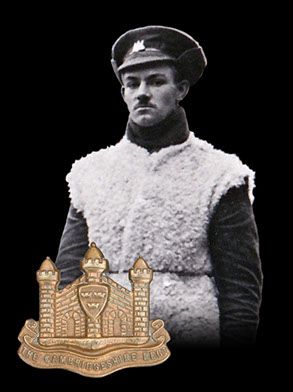
Clement Strange, the last Cambs man KiA.

This site went live on the 14th February 2015 to mark 100 years since the 1/1st Cambs went off to war.
WE WILL REMEMBER THEM
Email us: cambsregt@gmail.com
Copyright 2015, 2016, 2017, 2018, 2019 by Felix Jackson. The information and images on this site should not be reproduced without prior permission.